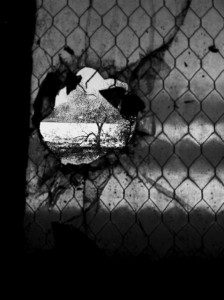The History of Histories (Part 5)
By Asher Crispe: November 5, 2012: Category Inspirations, Quest of the Question
Dual Deeds and Free Agents
Can anyone safely praise entropy? Would we have to become bored with order to embrace increasing disorder? And yet we have a profound attraction to disorder, to shaking things up, to varying our overly familiar circumstances and modifying ourselves. One sage of the Talmud (among the most famous), Rabbi Meir (also referred to as Rabbi Meir Ba’al HaNes ‘the master of miracles’) went so far as to identify entropy as ‘exceedingly good.’ In fact, as he saw it, entropy is an essential condition for growth and change.
In both Midrashic sources and in numerous places in the Zohar, Rabbi Meir’s extreme teaching on entropy can be traced back to one statement about Genesis 1:31 where “God [Elokim or God manifest immanently through the natural world] saw all that He has made, and behold it was very good. It became evening and it became morning the sixth day.” With an ironic twist, the towering talmudic genius ‘remarks’ in his own Torah that “and behold it was very good” should be registered as if it read “behold good death.”
For this attribution alone, it is easy to see why the other Sages could not walk the same intellectual path (at least to its end). An exceptional mind amongst the most exceptional minds, Rabbi Meir’s own learning of Torah, according to the Maggid of Mezeritch (Rabbi Dov Ber of Mezeritch), took the Torah to an entirely new level of self-integration. Prior to a person learning the Torah, this body of teachings is designated as the ‘Torah of God [Hashem or the transcendent aspect of Divinity which means Being].’ The implication is that the Torah (teachings) itself exists in a kind of amorphous generality. It is particular to no one but applicable to everyone. We are speaking of the teachings (Torah) of reality and existence as a whole (ontological). The act of study through which a person acquires the Torah should transform oneself, but it also ‘transforms’ our perception of the Torah into a highly individualized or personalized teaching. It becomes my Torah. I see myself within it. It is the story of my own ongoing autobiography as it unfolds in real time.
Thus, the Maggid glosses the intentional wording of the Midrash wherein the Hebrew specifies “b’Torato shel Rabbi Meir” meaning “within the Torah of Rabbi Meir.” The Torah of God did not change. It does not mean that he altered the writing of a physical Torah scroll to read differently than the tradition handed down to everyone else. Instead, the teachings became ‘his’ when he learned them passing the text through himself and himself through the text. The inner integration meant that his interpretation of the Torah was now his Torah, his teaching, the Torah of Rabbi Meir.
In another reframing of the issue, the Chassidic masters explain that he connected the Torah to the root of the Torah within the infinity of God. Souls (the interpretive community) join the text to the ultimate Divine source, reuniting the book with the Author via the reader. As a result, the nature of Rabbi Meir’s own psycho-spiritual complexion provided a new source of light from which the textual meaning could radiate.
While we have followed the convention of identifying Rabbi Meir as Rabbi Meir, the rabbinic establishment has long cast doubt on this designation as the original name of this sage. Many consider his original name to be Nahori. Some say he was later called Meir which means a ‘source of light’ due to his uncanny ability to enlighten the eyes of the other sages. Quite simply there were aspects of the Torah that others were not able to see on account of perceptual limitations. In the mind’s eye of the other sages, certain things appeared dark. With many details obfuscated, the whole picture would become deformed.
The optical metaphor at work here also involves the Torah itself which its likened to light (d’orita, as it is called in Aramaic, literally means ‘light comes’ in that Torah brings light to any situation). However, for every light there must be a light source. To increase the light there has to be an increase in light sources. Personifying these additional light sources, Rabbi Meir awakens that which is unnoticed or unconscious about the Torah within the purview of the other sages.
The Lubavitcher Rebbe (Torat Menachem 5744 Vol. 4 pp. 2508-2509) further elucidates this passage starting with an opening volley of questions where he contends that the very fact that death is mentioned in the Torah is itself problematic. In its essence the Torah is entirely within the category of the Holy (even when aspects of it appear to the contrary). It should therefore have no wasted words–no undesirable phenomenon mentioned within it. This too seems to be an indefensible statement unless one considered that in the inner dimensions of the Torah all aspects of Creation may have a positive or negative spin put to them. The significance of a person, place or thing, situation or event, can always be turned around and given a non-literal meaning that is the polar opposite for how it reads on the surface. Death is no exception.
Plainly, death is as negative and undesirable as it gets. Yet, the figurative meaning of death, which Rabbi Meir and many others after him equate with the possibilities of change and growth, just might take us places in the spirit of entropy that would be precluded were this not a feature of our world. While for the time being it qualifies as a descent, in the future, against the backdrop of our expanded consciousness, it will transform into the fuel for an ascent.
The Zohar (Vol. 3 135a), as is often cited, identifies death not with destruction of a person or created entity (there is total conservation of energy and by extension all life) but rather the fall from one’s level. Falling down and getting back up are not conditions of childhood and old age, they are existential facets of reality. Developmental processes carry the marching banner of ‘success though failure.’ We must first fall on a lower level before we can ascend to a higher level. On the largest plains of history, we witness this in all of epochal change–we stumbled with the punishing mills, mines and factories of industrialization until experience taught us enough so that we could begin to transcend it in the information age riding on the breakthroughs of computers and robotics. Revolution upon revolution (ideally) moves us forward, but not without the nullification of the previous frame.
In order to surpass one version of oneself, seemingly there must first be a clearing. This clearing can be practicing the act of forgetfulness, where one shelves an older and worn out way of thinking, in order to make room for a new one. This shake up seems to be simple replacement therapy. Out with the old and in with the new. But upon deeper reflection, the old provides the seed for the new. The old is even reincarnated within the new. Everything is carried forward.
Nothing in Rabbi Meir’s universe ever truly dies. Death itself is a blinding surplus of the good whose excess temporally hides the presence of the ‘living’ dead. Even in the abstract process of entropy, should we run the film strip in reverse, everything will be reassembled again. The destruction might then be seen as creative destruction. Had I not let go of that previous way of doing things, I would never have been open to this new way which is so much better than what I had before.
 Stranger still, the resurrection of the dead (and not merely in memory) allows for the paradoxical situation where life and death co-exist. On the level of cell biology we can taste a bit of this even today. In the swarm of cells that is my body, parts of me are dying while other parts are being born. Yet, I am still me. I hold within my physical constitution life and death cycling over and over again at every moment.
Stranger still, the resurrection of the dead (and not merely in memory) allows for the paradoxical situation where life and death co-exist. On the level of cell biology we can taste a bit of this even today. In the swarm of cells that is my body, parts of me are dying while other parts are being born. Yet, I am still me. I hold within my physical constitution life and death cycling over and over again at every moment.
The tone of the voice of Rabbi Meir produces many new sounds in the reading of the ‘Awesome acts’ of God that are directed to the descendants of Adam. Awe is some kind of wonderful wonderment. The excitement of Creation (or recreation) is not when everything stays the same and it is also not in death in the literal sense, but perhaps it is found in the death of death (or at least the death of the certainty of death as that which opposes life).
In Part Six the question of entropy as the force of history will continue.
http://www.interinclusion.org/inspirations/the-history-of-histories-part-6/
http://www.interinclusion.org/inspirations/the-history-of-histories-part-4/














;)
;)
;)
;)
;)
;)
;)
;)
;)
;)
